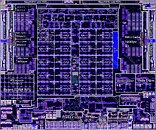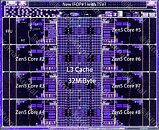- Joined
- Aug 19, 2017
- Messages
- 2,921 (1.05/day)
AMD's "Strix Halo" APU, marketed as Ryzen AI Max+, has just been exposed in die-shot analysis. Confirming the processor's triple-die architecture, the package showcases a total silicon footprint of 441.72 mm² that integrates advanced CPU, GPU, and AI acceleration capabilities within a single package. The processor's architecture centers on two 67.07 mm² CPU CCDs, each housing eight Zen 5 cores with a dedicated 8 MB L2 cache. A substantial 307.58 mm² I/O complements these die that houses an RDNA 3.5-based integrated GPU featuring 40 CUs and AMD's XDNA 2 NPU. The memory subsystem demonstrates a 256-bit LPDDR5X interface capable of delivering 256 GB/s bandwidth, supported by 32 MB of strategically placed Last Level Cache to optimize data throughput.
The die shots reveal notable optimizations for mobile deployment, including shortened die-to-die interfaces that reduce the interconnect distance by 2 mm compared to desktop implementations. Some through-silicon via structures are present, which suggest potential compatibility with AMD's 3D V-Cache technology, though the company has not officially confirmed plans for such implementations. The I/O die integrates comprehensive connectivity options, including PCIe 4.0 x16 lanes and USB4 support, while also housing dedicated media engines with full AV1 codec support. Initial deployments of the Strix Halo APU will commence with the ASUS ROG Flow Z13 launch on February 25, marking the beginning of what AMD anticipates will be broad adoption across premium mobile computing platforms.



View at TechPowerUp Main Site | Source
The die shots reveal notable optimizations for mobile deployment, including shortened die-to-die interfaces that reduce the interconnect distance by 2 mm compared to desktop implementations. Some through-silicon via structures are present, which suggest potential compatibility with AMD's 3D V-Cache technology, though the company has not officially confirmed plans for such implementations. The I/O die integrates comprehensive connectivity options, including PCIe 4.0 x16 lanes and USB4 support, while also housing dedicated media engines with full AV1 codec support. Initial deployments of the Strix Halo APU will commence with the ASUS ROG Flow Z13 launch on February 25, marking the beginning of what AMD anticipates will be broad adoption across premium mobile computing platforms.



View at TechPowerUp Main Site | Source







